Angelica archangelica
If you are looking to add some flair to your herb garden this year, look no further than angelica.
Referred to as the “herb of the sun” by the famous 17th century British herbalist Nicholas Culpeper, this plant will welcome visitors to the garden with its pleasant, aromatic scent and impressive stature.

We link to vendors to help you find relevant products. If you buy from one of our links, we may earn a commission.
Growing angelica is pretty easy once you get started, and it will reward you with a unique source of food, flavoring, and herbal remedies.
What You’ll Learn
What Is Angelica?
Angelica, a member of the Apiaceae family, has long been cultivated for its edible stems and roots. It has a commanding presence in the garden, sometimes reaching a towering eight feet in height.
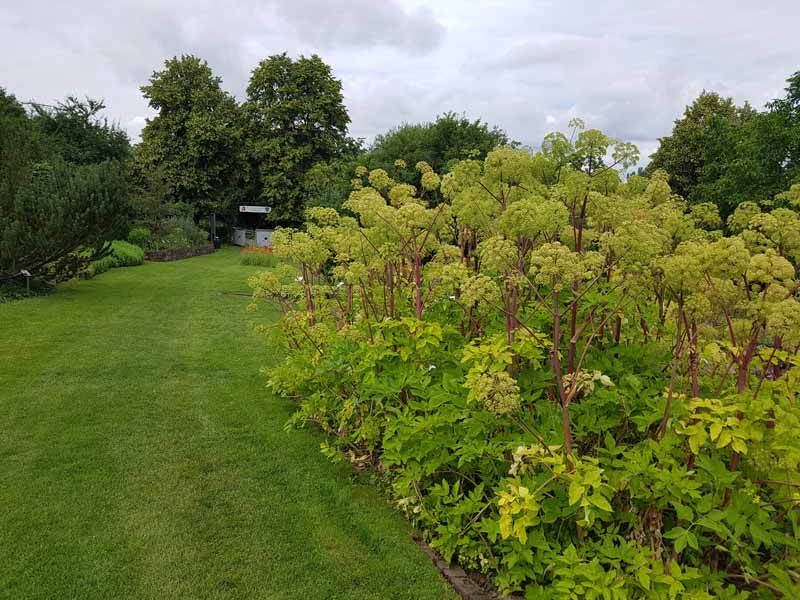
It has long, stout, hollow stems of green or purple, with bold, bright green leaflets that are finely toothed or serrated.
The foliage is divided into three principal groups, which are again divided into three smaller clusters.
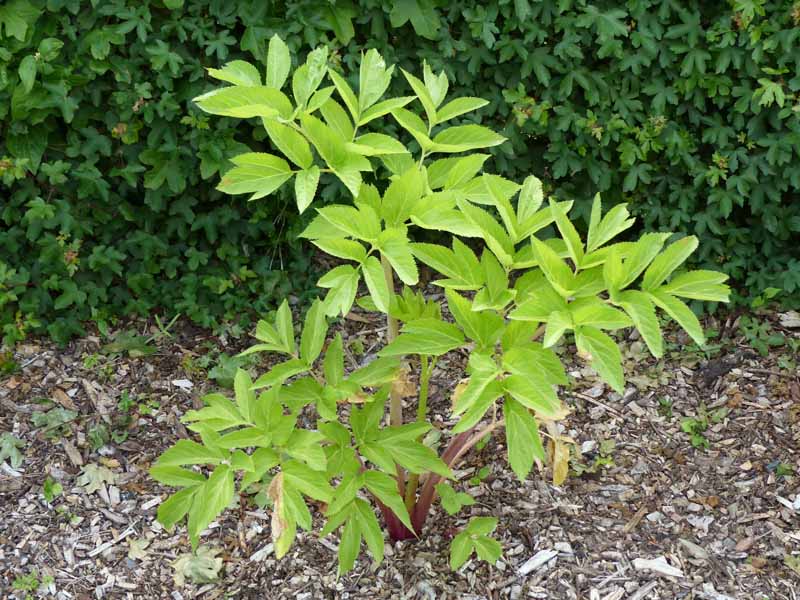
Large, round flower heads contain multiple yellow or green umbels, which bloom in midsummer and are succeeded by pale, yellow, oblong fruits.
Its large, spindle-shaped roots are thick and fleshy.
Angelica is a biennial in USDA Hardiness Zones 4 to 9, which means each plant reaches maturity within a two-year cycle. In colder locations it can take three to four years to mature and flower.
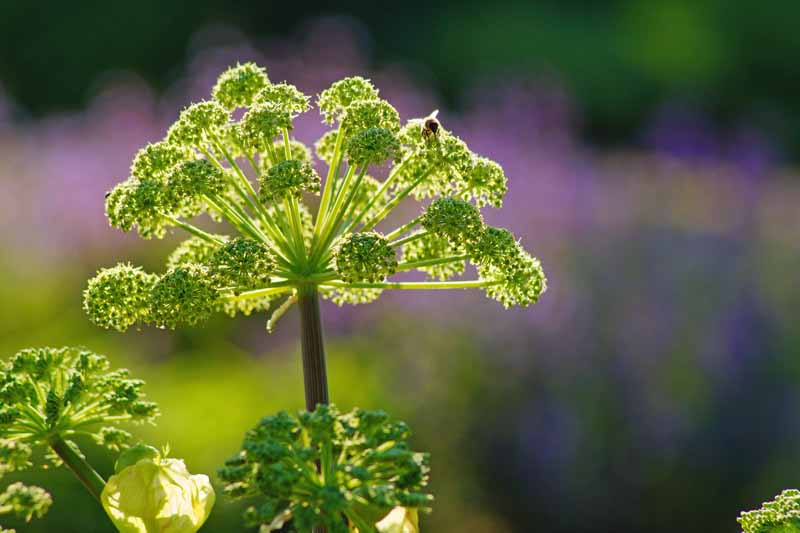
In the first year, the plant produces only short clumps of compound leaves.
It grows tall in the second year, with flowers blooming in midsummer, followed by fruiting and going to seed.
Once the seeds have ripened and been dispersed, the life cycle is complete, and plants generally die. However, if you cut off the flower stalks before the seeds form, the plant will continue to grow for many more years.
Though each plant may only live for a couple of years, it self seeds easily, so you will likely see new plants popping up year after year.
Cultivation and History
Angelica has been cultivated for food and medicine since at least 800 AD.
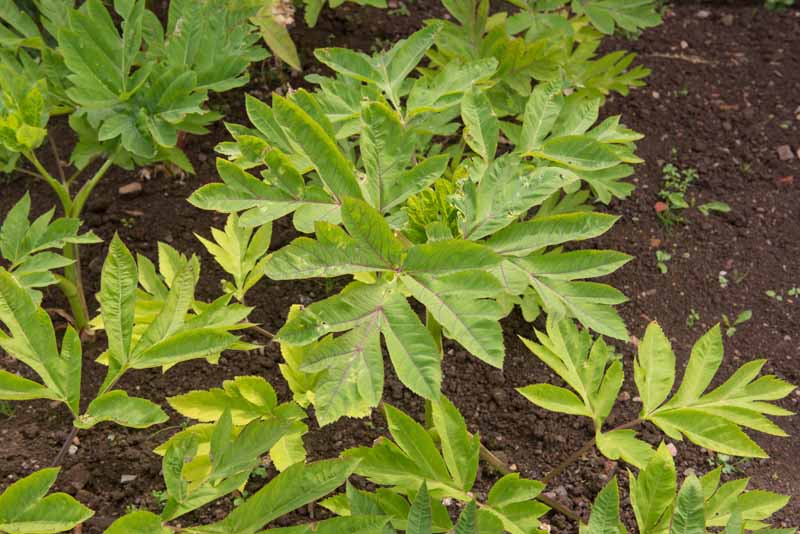
Though its exact origin isn’t known, it is thought that this plant is likely native to the Middle East, possibly Syria, or to northern European countries, including Norway, Russia, and Lithuania.
It grows wild in the northern climates of Russia, Finland, Sweden, Norway, Denmark, Greenland, and Iceland.
When Vikings started trading in Europe during the 9th century, it was an important commodity. In early Icelandic law, a person could be fined for stealing angelica from someone else’s garden patch.
According to legend, a 14th century monk was visited in a dream by an angel who revealed angelica to him as a cure for the plague. All parts of the plant were believed to be effective in warding off evil spirits, witches, and spells, as well as the Black Death.
Sometimes referred to as “holy ghost root,” this herb was considered one of the most powerful plant medicines at the time.
Along with nutmeg and treacle, angelica water was an ingredient in “the King’s Majesty’s Excellent Recipe for the Plague,” a remedy – to be taken twice a day – published by the Royal College of Physicians, in the 1600s.
Candied angelica, a confection made from the stems, was first produced and marketed by the Danes. By the early 17th century, candied roots and stems were popular in England.
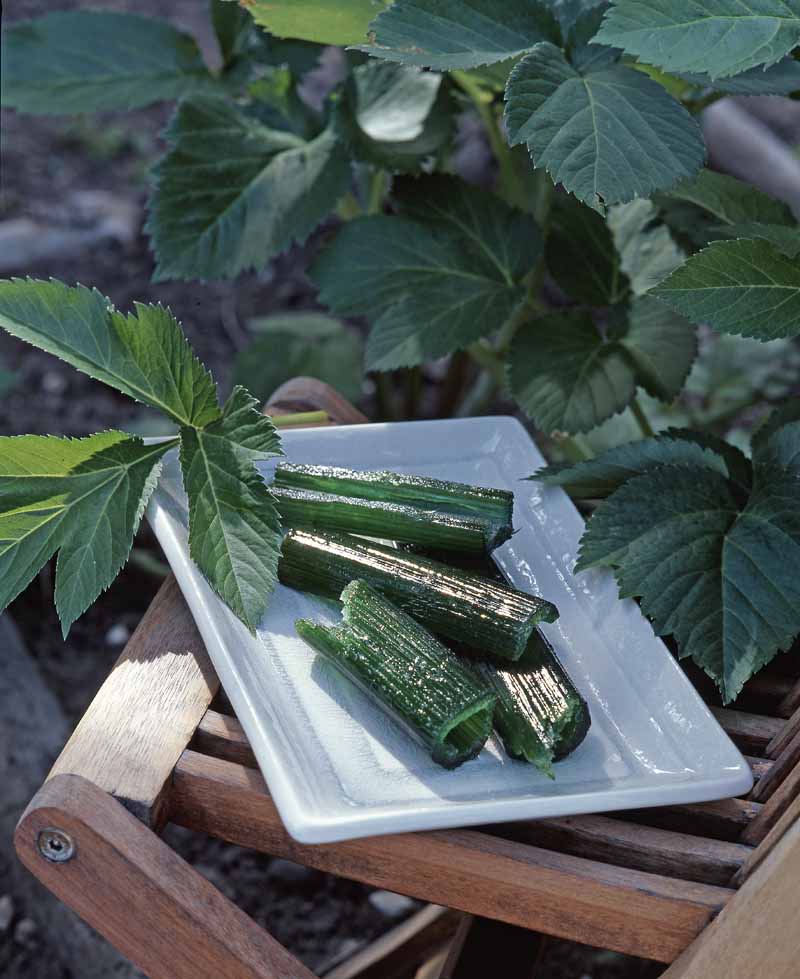
The aromatic root is used in France to flavor liqueurs such as Chartreuse, and “Angelica” is also its own branded product – an herbal liqueur made in Massachusetts.
It is also a popular ingredient in gin distillation, often combined with coriander and juniper berries.
A. atropurpurea, commonly known as purple stem angelica, is a species native to eastern North America, found in moist and swampy woodlands, mostly by riverbanks.
This species has similar characteristics to A. archangelica, and has a long history of use among Native American cultures in food and medicine.
Medicinal Use of Angelica
The fleshy root is the primary part used in herbal remedies, though seeds and leaves are sometimes used as well. Historically, the stalks have been candied and used mainly as a confection.
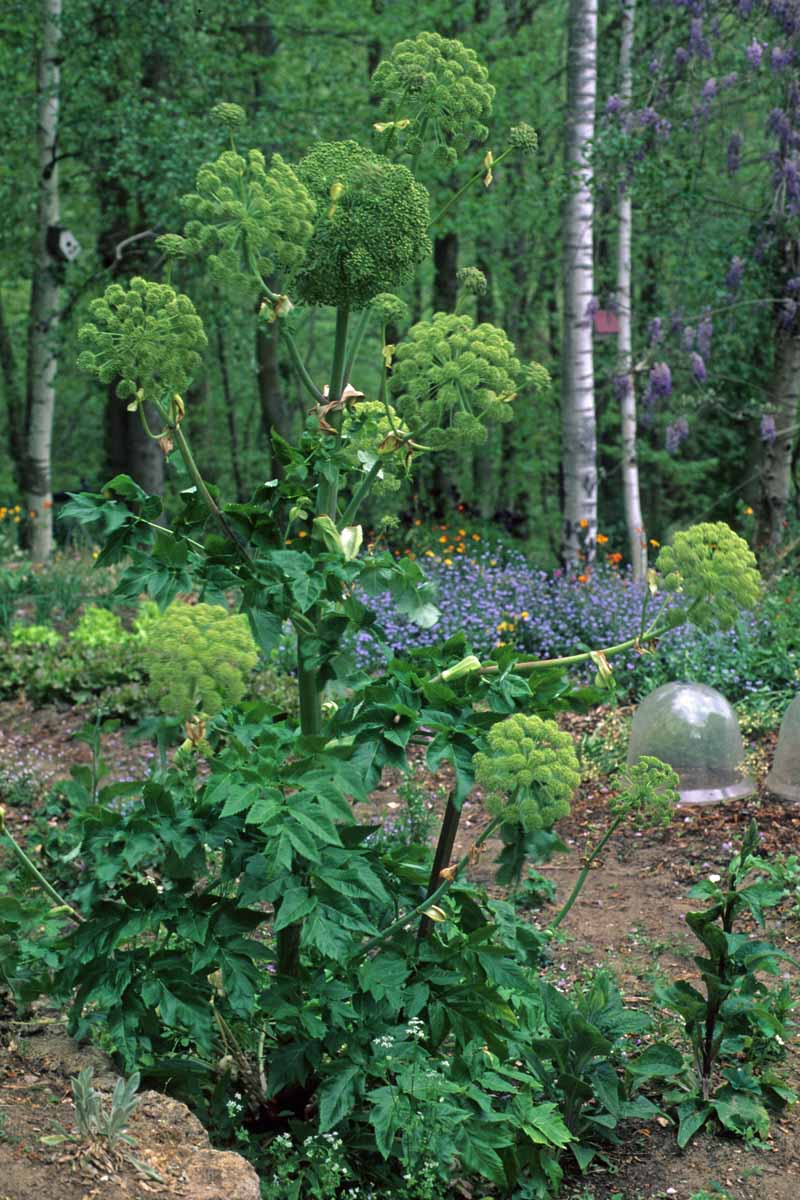
Considered a warming and aromatic bitter tonic, angelica is often used to help improve weak digestive function, including indigestion, poor fat absorption, a feeling of heaviness, and heartburn.
It has also been recommended by herbalists to those with respiratory conditions such as chronic bronchitis and COPD, to relieve bladder infections, and to bring on delayed menstrual periods.
A leaf compress can be applied to the chest to reduce inflammation, and ear drops made from the herb can be used to combat clogged ears and improve hearing loss due to waxy buildup.
According to herbalist Matthew Wood in his book “The Earthwise Herbal Repertory: The Definitive Practitioner’s Guide,” burning the root as an incense helps to relax the mind and body and open the imagination, allowing the mind to enter what shamanic herbalists refer to as “dreamtime.”

The Earthwise Herbal Repertory, available via Amazon
A Note of Caution:
Always consult with a medical professional or trained herbalist before beginning any herbal treatment. This herb should not be used during pregnancy, or by those who take blood thinners or other prescription medication.
Angelica Plant Propagation
Angelica is usually propagated from seed or transplants. Once you get a patch going, this herb will largely take care of itself.
To help established plants continue to self seed, simply pull back any mulch in the autumn so the seeds will fall directly onto the soil below. Leave flower heads on the plants so the seeds can mature and drop, and new plants will sprout in the spring.
Division of this plant is not recommended. For medicinal use, most growers want the root to get as big as possible, and allow it to grow through two seasons. But if you choose to divide nonetheless, instructions are included below.
From Seed
Seeds are best planted when they are fresh and ripe.
If you have access to already established angelica plants, you can save seeds by securing a paper bag over the mature flower heads.
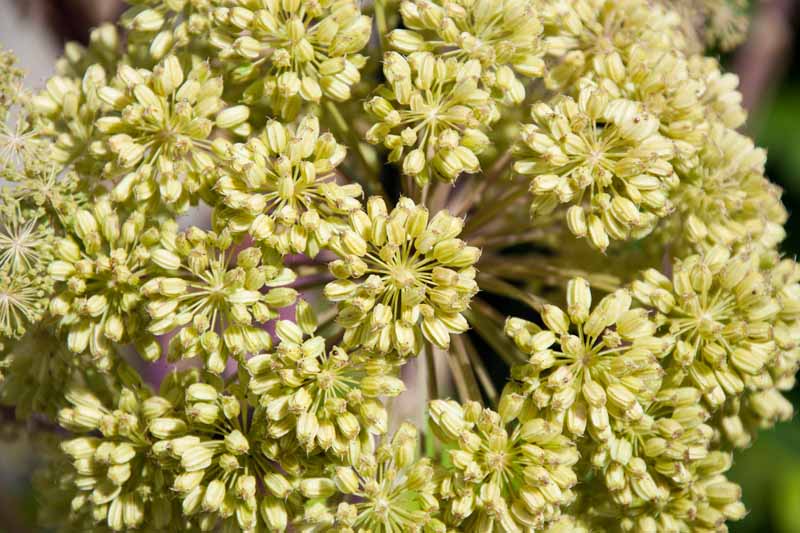
The seeds will collect inside the bag instead of falling to the soil below.
Once collected in early fall, the fresh seeds can be pressed into the soil surface in a sunny location, preferably when air temperatures are between 60 to 65°F. Do not cover the seeds with soil, as they require light to germinate. Keep the soil moist until seedlings appear.
If fresh seeds are not available, you can propagate angelica from dried seed, just bear in mind that germination rates will be lower.
Refrigerate seeds for a few weeks prior to planting out in the garden, to cold stratify. Sow in the fall or early spring on the surface of the soil. Keep garden beds lightly moist until germination.
From Seedlings or Transplants
Starting fresh seeds in the fall is best, but you can also do an early spring planting if you prefer. If you are sowing in spring, you’ll need to refrigerate the stored seeds for a few weeks before planting.
Sow seeds into rich potting soil in flats or small pots. Since germination rates for stored seeds are quite low, be liberal with the number of seeds sown per pot.
According to Ruth Smith, from the University of New Hampshire Cooperative Extension, this plant requires alternating temperatures of warm and cold in order to germinate. Place the flats or pots outside where they will be subject to fluctuations in temperature. Be sure to bring them inside if you are expecting a freeze.
You can also simulate daily temperature fluctuations by keeping plants on a windowsill during the day and moving them into a refrigerator each night. During this stratification period, make sure they are getting adequate water.
You can bring the trays indoors after 21 days to germinate. Place them in an area where temperatures will remain consistently above 60°F. They should germinate after 21 to 28 days.
Transplant seedlings outside in the spring when they are three to four inches tall. Space seedings 12 to 24 inches apart in rows 36 inches apart.
Division
You can also propagate by dividing the roots of established plants in the second year of growth, in the spring before flowering, or in the fall when plants go dormant.
Cut back the plant to about a foot or so from the ground so it is easier to work with. Take a sharp spade and divide the plant down the center, or remove the entire plant and divide the roots into two to three sections, depending on the size of the root.
Replant each piece in a garden bed amended with compost, spacing 18 to 24 inches apart.
Divisions may fail to thrive if the taproot is damaged.
Read our full guide to angelica propagation here.
How to Grow Angelica
This herb prefers rich, moist, and slightly alkaline soil, though it will tolerate almost any soil type.

Moisture is important, however, as it does not tolerate dry conditions well. Be sure to keep the soil well watered, and mulch liberally to help retain moisture.
It should be planted in a full sun to part shade location. Since this herb is native to cool climates, in hotter zones it is a good idea to plant it in partial shade to protect it from the heat.
Once plants are established, maintenance is fairly easy. Keep plants free of weeds and water regularly at the base to prevent fungal diseases.
Growing Tips
- Start seeds in peat pots to avoid disturbing roots when transplanting.
- Do not attempt to transplant plants larger than 3 to 4 inches tall, as established plants have sensitive taproots.
- Cutting stalks at the end of the first year of growth will encourage flowering in the second year.
- Keep soil evenly moist but not waterlogged.
- Mulching will prevent the soil from drying out and inhibit the growth of weeds.
Where to Buy
If you want to add A. archangelica to your herb garden, seeds are sometimes available from nurseries and garden centers.
You can find packets of 50 seeds available at Earthbeat Seeds.
A. archangelica ‘Holy Ghost’ is suitable for growing in Zones 3 to 10 and will reach a mature height of up to five feet tall.
You can find seeds available for purchase at Eden Brothers.
Managing Pests and Disease
While not particularly prone to pests or disease, there are a few pesky critters and potential problems to keep an eye out for.
Insects
You may find these pests bothering your angelica plants occasionally:
Aphids
These pesky little sap-sucking bugs will feed on the green foliage, and can cause wilting of leaves, a decline in plant vigor, and stunted growth. Aphids also secrete honeydew, a sticky residue that can cause mold to grow on leaves.
Weed regularly to reduce the risk of aphid infestation. You can eradicate these pests with diatomaceous earth, or a homemade insecticidal soap made with water and a few drops of dish soap.
Learn more about managing aphids in the garden here.
Leaf Miners
This insect category refers to a variety of moths and flies which eat through leaf tissue when in the larval stage. Damage can appear as spots, blotches, or squiggly lines through foliage.
Applying neem oil will disrupt the miners’ life cycle and reduce infestations. You can also put out sticky traps to catch the adults before they lay their eggs.
Find more information on identifying and combating leaf miners here.
Spider Mites
Related to spiders, these arachnids live underneath leaves and pierce leaf tissue to feed, sucking out the fluids. They will cause spotting and yellowing of leaves, and may eventually cause foliage to drop entirely.
Try applying a homemade insecticidal soap mixed with neem oil to get rid of them.
Read more about identifying and controlling spider mites here.
Disease
Angelica doesn’t suffer from much in the way of disease, but under certain conditions you might need to keep an eye out for the following:
Crown Rot
This soil borne fungal disease causes rotting of the stems at the base of plants near the soil line, and may also cause leaves to yellow, wilt, and die.
Treatment is difficult, as the fungus that causes this disease, Pellicularia rolfsii, can live in the soil indefinitely.
It’s most commonly seen in wet conditions and heavy soils, and can spread via flowing water.
If rotting is discovered, remove and dispose of diseased plants as soon as you notice them.
Prior to replanting a new crop, solarize the soil that has been infected by covering it with plastic for two to three months in the heat of summer.
You can also amend heavy, clay soils with compost to improve drainage and reduce the risk of future disease.
It is also helpful to water plants at the base, completely avoiding the leaves, and apply mulch to encourage adequate drainage.
Get more tips on identifying and controlling crown rot here.
Harvesting Angelica
All parts of angelica are edible.
The leaves can be harvested in the first year. Cut off leaves as needed, being careful not to damage the main stem.

Harvest the root in autumn of the first year, or spring of the second year, before the stalk has grown tall and begun to produce flower heads.
When you are harvesting, always be sure to leave some of the plant intact to flower and go to seed, so it will continue to self sow year after year.
Read our full angelica harvesting guide here.
Preserving
Angelica can be preserved in a variety of ways.
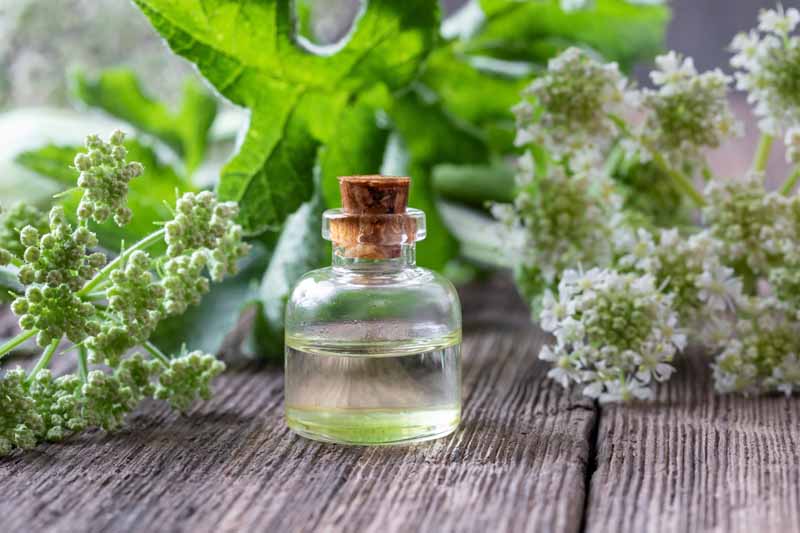
The root can be dried, made into a tincture, or ground into a powder. Dry the leaves to use them as a culinary flavoring. Find tips on drying herbs here.
You can also candy the stems, or use them to make jam.
For more ideas and detailed information on how to harvest and preserve angelica, check out our harvesting guide.
Quick Reference Growing Guide
| Plant Type: | Biennial herb | Tolerance: | Various soil types, acidic soil |
| Native to: | Northern Europe, Middle East | Maintenance: | Low |
| Hardiness (USDA Zone): | 4-9 | Soil Type: | Any |
| Season: | Spring-fall | Soil pH: | 4.5-7.0 |
| Exposure: | Full sun to part shade | Soil Drainage: | Moist |
| Time to Maturity: | 2 years | Attracts: | Bees, butterflies, lacewings, ladybugs, wasps |
| Spacing: | 12-24 inches | Companion Planting: | Ferns, hellebores, lily of the valley, sweet woodruff |
| Planting Depth: | Surface (seeds) | Avoid Planting With: | Dill |
| Height: | 3-8 feet | Family: | Apiaceae |
| Spread: | 2-4 feet | Genus: | Angelica |
| Water Needs: | Moderate to high | Species:: | archangelica |
| Common Pests: | Aphids, leaf miners, spider mites | Common Disease: | Crown and root rot |
An Angelic Herb for Your Garden
Angelica is such a magnificent plant with so many interesting uses.
It may take a bit of patience to get yours started, but once you do, this impressive herb will reward you with its striking stalks, lovely flowers, and juicy roots, year after year.

Do you have experience growing angelica in your garden? Share your tips in the comments below!
And information about other medicinal plants to grow in your garden, check out these guides next:

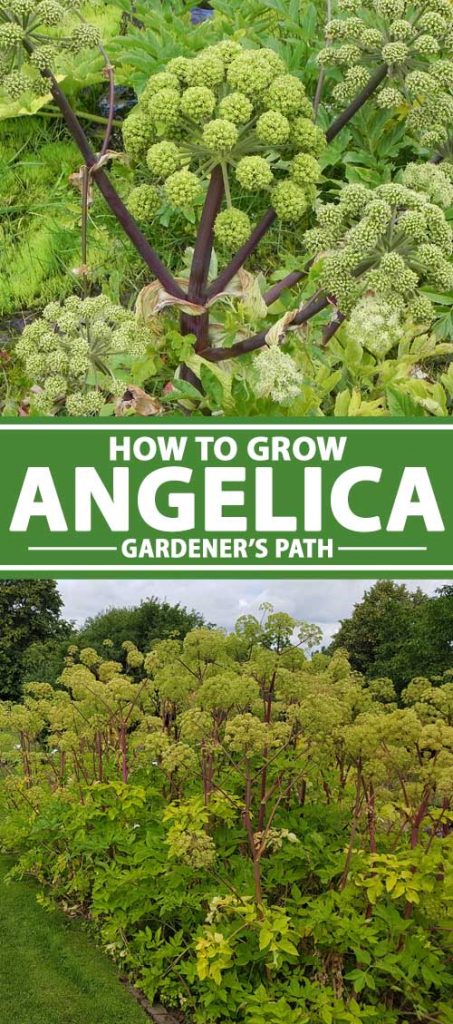
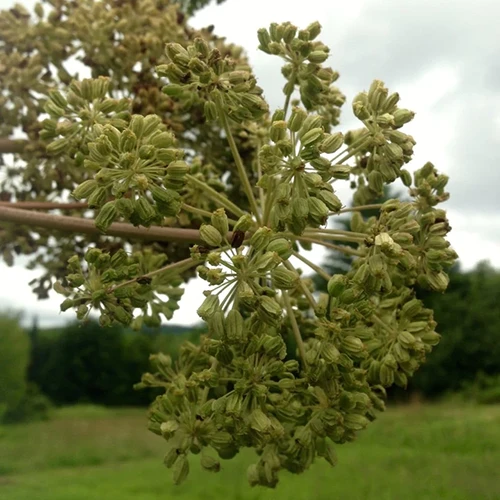
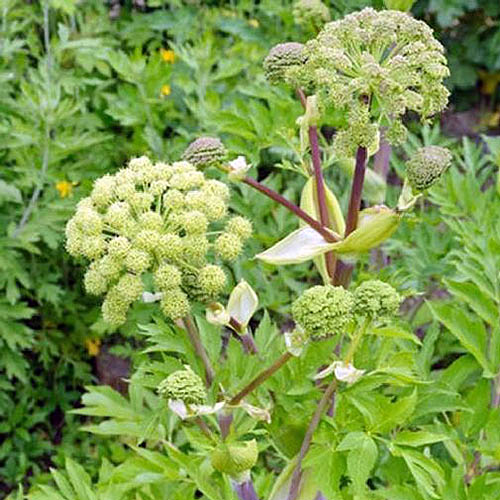
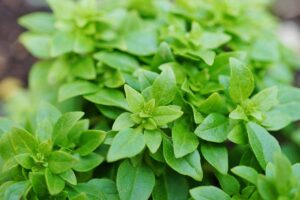


Our Angelica was planted last year and died back in the winter. Then it regrew and is now, in June, 7 feet tall and 4 feet wide, approx. It has around 42 heads which are green. It’s an amazing plant to see but best of all, insects love it. A good talking point for any garden.
Thanks for sharing! What a happy healthy plant 🙂
Hi! I am new to growing Angelica. My plants are in their second year and are really tall and fragrant! They have flowered, so it’s too late to harvest the roots. I want them to grow back next year, so should I cut off the flowering heads now ( mid June) but leave some to go to seed? I’m afraid if I wait too long they will die and not come back.
Go ahead and cut off all those spent flowering heads right now if you want the whole plant to return next year. Otherwise, it might think its job is done and it will die back.